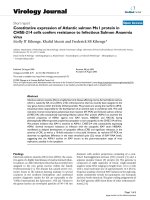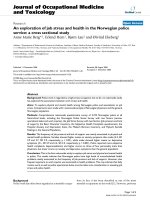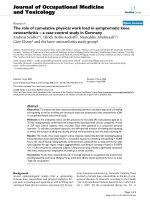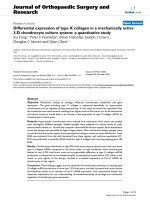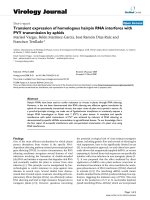báo cáo hóa học:" Constitutive expression of Atlantic salmon Mx1 protein in CHSE-214 cells confers resistance to Infectious Salmon Anaemia virus" docx
Bạn đang xem bản rút gọn của tài liệu. Xem và tải ngay bản đầy đủ của tài liệu tại đây (394.01 KB, 6 trang )
BioMed Central
Page 1 of 6
(page number not for citation purposes)
Virology Journal
Open Access
Short report
Constitutive expression of Atlantic salmon Mx1 protein in
CHSE-214 cells confers resistance to Infectious Salmon Anaemia
virus
Molly JT Kibenge, Khalid Munir and Frederick SB Kibenge*
Address: Department of Pathology and Microbiology, Atlantic Veterinary College, University of Prince Edward Island, 550 University Avenue,
Charlottetown, PE. C1A 4P3. Canada
Email: Molly JT Kibenge - ; Khalid Munir - ; Frederick SB Kibenge* -
* Corresponding author
Abstract
Infectious salmon anaemia (ISA) is a highly fatal viral disease affecting marine-farmed Atlantic salmon
which is caused by ISA virus (ISAV), a fish orthomyxovirus that has recently been assigned to the
new genus Isavirus within the family Orthomyxoviridae. Mx proteins are among the interferon (IFN)-
induced proteins responsible for the development of an antiviral state in vertebrate cells. We used
real-time reverse transcription-polymerase chain reaction (RT-PCR) and Chinook salmon embryo
(CHSE-214) cells constitutively expressing Atlantic salmon Mx1 protein (ASMx1) to examine the
antiviral properties of ASMx1 against two ISAV strains, NBISA01 and HKS-36, having
phenotypically different growth properties (cytopathic vs non-cytopathic) in the CHSE-214 cell line.
We present evidence that ISAV is sensitive to ASMx1. CHSE-214 cells constitutively expressing
ASMx1 showed increased resistance to infection with the cytopathic ISAV strain NBISA01,
manifested as delayed development of cytopathic effects (CPE) and significant reduction in the
severity of CPE, as well as a 10-fold reduction in virus yield. However, by real-time RT-PCR we
observed no significant difference in the mean threshold cycle (Ct) values of ISAV RNA levels,
suggesting that the ASMx1 activity on ISAV occurs at the post-transcription steps of virus
replication, possibly in the cytoplasm.
Findings
Infectious salmon anaemia (ISA) virus (ISAV), the causa-
tive agent of a highly fatal disease of marine-farmed Atlan-
tic salmon, is a fish orthomyxovirus that has recently been
assigned to the new genus Isavirus within the family
Orthomyxoviridae [1]. The disease has caused severe eco-
nomic losses to the salmon-farming industry in several
countries in the northern hemisphere, and confirmed
positive diagnostic results for ISA are reportable to the
"Office International des Epizooties", OIE [2]. Viruses in
the genus Isavirus are enveloped particles of 90–140 nm
diameter with surface projections consisting of a com-
bined haemagglutinin-esterase (HE) protein [3] and a
separate putative fusion (F) protein [4]. The genome is
composed of eight segments of linear, single-stranded
negative sense RNA ranging in length from 1.0 to 2.4 kb
with a total molecular size of approximately 14.3 kb [5].
Sequence analysis of several ISAV isolates on the eight seg-
ments consistently reveals two genotypes, one European
and one North American. The gene-coding assignments of
the ISAV genome differ from those of other orthomyxovi-
ruses [2,4].
Published: 26 August 2005
Virology Journal 2005, 2:75 doi:10.1186/1743-422X-2-75
Received: 08 July 2005
Accepted: 26 August 2005
This article is available from: />© 2005 Kibenge et al; licensee BioMed Central Ltd.
This is an Open Access article distributed under the terms of the Creative Commons Attribution License ( />),
which permits unrestricted use, distribution, and reproduction in any medium, provided the original work is properly cited.
Virology Journal 2005, 2:75 />Page 2 of 6
(page number not for citation purposes)
Some strains of ISAV can replicate and cause CPE in the
CHSE-214 cell line while others do not replicate in this
cell line at all [6,7]. The molecular basis for this pheno-
typic difference is not clearly known. Although there is a
strong geographical correlation in that practically all ISAV
isolates of the European genotype do not cause CPE in the
CHSE cell line, this phenotype is not related to sequence
variation in the HE protein [8].
In general, fish viral diseases are difficult to control due to
the high susceptibility of fish at an early age, and insuffi-
cient knowledge of pathogenesis of virus infections. In
this context, we are studying the mechanisms by which
ISAV interacts with its host, including the identification of
markers for ISAV virulence. Vertebrates [9], including fish
[10], mount an early strong innate immune response
against virus infections, characterized by the induction
and secretion of cytokines, such as type I interferons (IFN-
α/β) that mediate an antiviral state. Secreted IFNs signal
through a common receptor activating a JAK/STAT signal-
ing pathway which leads to the transcriptional upregula-
tion of numerous IFN-stimulated genes (ISGs), a number
of which encode antiviral proteins [10-12]. The induced
antiviral proteins include dsRNA-dependent protein
kinase R (PKR), 2',5'-oligoadenylate synthetase (OAS),
and the Mx proteins [10,12]. Viruses have evolved mech-
anisms to subvert the host IFN response [12,13]. Previous
in-vitro studies revealed that ASMx1 inhibited the replica-
tion of infectious pancreatic necrosis virus (IPNV), a
dsRNA virus belonging to the Birnaviridae family, but it
did not appear to inhibit replication of ISAV [14,15]. It
was concluded from those results that ISAV and IPNV
have developed different strategies to avoid the IFN-sys-
tem of Atlantic salmon. Thus, we were interested in ana-
lyzing ISAV strains having phenotypically different
growth properties in the CHSE-214 cell line to gain fur-
ther insight in ISAV virulence. We present evidence that
ISAV is sensitive to the antiviral activity of ASMx1.
The following two ISAV isolates were selected for use in
this study: NBISA01 and HKS-36. The growth properties
of the isolates in CHSE-214 cells have been previously
described [6]. NBISA01 is CPE-positive whereas HKS-36 is
CPE-negative in CHSE-214 cells. For use, the viruses were
propagated and titrated in CHSE-214 cells and/or TO cells
as previously described [6,8]. To demonstrate the effects
of ASMx1 on the replication of the two ISAV strains, we
compared the cytopathogenicity and virus yields of the
viruses in normal CHSE-214 cells and in cells constitu-
tively expressing ASMx1. The CHSE-214 cells constitu-
tively expressing ASMx1 [15] were a kind gift from Dr.
Børre Robertsen, Norwegian College of Fishery Science,
University of Tromsø, Norway. These cells were grown in
presence of 0.5 mg/ml zeocine (Invitrogen Life Technolo-
gies) to maintain expression of the transfected genes (Dr.
Børre Robertsen, personal communication). Virus stocks
were prepared from TO cell cultures infected with the
selected ISAV isolates which were harvested when CPE
was complete; usually 7–9 days post inoculation (dpi).
They contained 10
8.16
TCID
50
/ml for NBISA01, and
10
7.16
TCID
50
/ml for HKS-36. CHSE-214 cell monolayers
in 25 cm
2
tissue culture flasks, each inoculated with 1 ml
of virus, were monitored daily for CPE and were harvested
14 dpi. Viral titers of the harvests were determined on nor-
mal CHSE-214 cells in 48-well tissue culture plates as pre-
viously described [6]. A significant delay in development
of CPE and a reduction in the severity of CPE, as well as a
10-fold reduction in virus yield were observed for
NBISA01 grown in CHSE-214 cells constitutively express-
ing ASMx1 compared to normal CHSE-214 cells (Table 1).
No CPE was seen with HKS-36 in both types of CHSE-214
cells.
In an attempt to assess the effects of ASMx1 on the viral
mRNA levels, we used real-time RT-PCR in the LightCycler
with RNA Amplification Kit SYBR Green I (Roche Applied
Science) and PCR primers FA-3/RA-3 targeting a 220-bp
product on ISAV segment 8 [7]. This assay has been shown
to be 100 times more sensitive than the conventional one-
tube RT-PCR assay, and to differentiate ISAV isolates into
three CHSE phenotypes (replicating cytopathic, replicat-
ing non-cytopathic, and non-replicating) based on their
ability to replicate and cause CPE in CHSE-214 cells [7].
Total RNA was extracted from 300 µl of cell culture super-
Table 1: Inhibition of ISAV NBISA01 by AsMx1 in CHSE-214 cells.
CHSE-214 cells
1
CPE development
2
CPE severity
3
Virus titer
4
Normal 5–14 days Complete (5+) 5.50
ASMx1 overexpression 6-* days Incomplete (3+) 4.50
1
CHSE-214 cells: Normal CHSE-214 cells and CHSE-214 cells constitutively expressing ASMx1.
2
CPE development denotes time from first appearance to complete CPE in days post inoculation; * indicates incomplete CPE development by 14
days post inoculation.
3
CPE severity was scored from 1+ to 5+: Complete CPE was scored 5+; Incomplete CPE scored 1+ to 4+).
4
Virus titers are expressed as TCID
50
/ml.
Virology Journal 2005, 2:75 />Page 3 of 6
(page number not for citation purposes)
natants of the uninfected and ISAV-infected tissue cultures
harvested at 14 dpi by using TRIZOL reagent (Invitrogen
Life Technologies). The RNA pellet was dissolved in 10 µl
of RNase free water and 1 µl was used in real-time RT-PCR.
The assay was performed on three replicates of each virus
sample. The thermal conditions were one cycle of reverse
transcription at 55°C for 30 min, pre-denaturation at
95°C for 30 s followed by 50 cycles of 95°C for 5s, 59°C
for 10s, 72°C for 10s, and data acquisition at 80°C for 2s.
Melting curve analysis was performed from 70°C to 95°C
in 0.1°C/s increments to assess the specificity of the RT-
PCR products. The quantitative (Ct values) and melting
curve data were analyzed using LightCycler software ver-
sion 3.5 (Roche Applied Science). The real-time amplifica-
tion reaction products were also resolved by 1% agarose
gel electrophoresis in 0.5 × TBE buffer and visualized by
staining with ethidium bromide and photographed under
304 nm UV light.
The real-time RT-PCR data are shown in Figures 1,2,3. The
mean Ct value of ISAV RNA levels for NBISA01 was 17.39
± 0.24 in normal CHSE-214 cells (Fig. 1A) and 17.62 ±
0.08 in CHSE-214 cells constitutively expressing ASMx1
(Fig. 2G). For HKS-36, the mean Ct value was 22.94 ± 0.08
in normal CHSE-214 cells (Fig. 1D) and 21.08 ± 0.003 in
CHSE-214 cells constitutively expressing ASMx1 (Fig. 2J).
For each virus strain, there was no significant difference in
the Ct values of both types of CHSE-214 cells. Melting
curve analysis showed that the T
m
of the ISAV templates
was 82.5 ± 0.03°C and occurred as a single amplicon peak
for both NBISA01 and HKS-36 in normal CHSE-214 cells
(Fig. 1B, E) and in CHSE-214 cells constitutively express-
ing ASMx1 (Fig. 2H, K). All these amplicons had one band
of 220 bp on agarose gel (Fig. 1C, F and Fig. 2I, L), indi-
cating virus-specific amplification and uniform virus pop-
ulations in the individual virus samples. The melting
curve analyses of amplification products of uninfected
CHSE-214 cells and water control indicated the presence
of primer dimers having values of 77.4 ± 0.01°C (Fig. 3N,
Q) and 78.1°C (Fig. 3T), respectively. No viral amplicon-
specific melting peaks were observed in these samples.
The absence of the 220 bp band on agarose gel in these
samples (Fig. 3O, R, U) further confirmed the validity of
melting curve analyses of these samples. Thus, by real-
time RT-PCR we were not able to detect any effect of the
ASMx1 activity on ISAV replication for both NBISA01 and
HKS-36. In case of NBISA01, this indicated to us that there
was no correlation between the virus yields (Table 1) and
the Ct values (Fig. 1A and Fig. 2G). This would be
expected since the real-time RT-PCR detected both mRNA
and viral genomic RNA and was not indicative of infec-
tious virus. Moreover, RNA detected by real-time RT-PCR
could be from infectious as well as non-infectious viral
progeny. These observations allow us to speculate that the
ASMx1 activity on ISAV occurs at the post-transcription
steps of virus replication. The human and mouse Mx pro-
teins are known to inhibit different steps of the influenza
virus multiplication cycle [16] which is dictated by their
intracellular locations. The mouse Mx1 protein accumu-
lates in the nucleus and interferes with primary transcrip-
tion of influenza virus in the nucleus, whereas the human
MxA protein which is localized in the cytoplasm inhibits
a subsequent step that presumably takes place in the cyto-
plasm of infected cells. ASMx1 has been reported to local-
ize in the cytoplasm [15]. Thus in this context, the ASMx1
activity on ISAV may resemble that of the human MxA
protein on influenza A virus.
To our knowledge these are the first studies demonstrating
that ASMx1 interferes with ISAV replication and suggest
that this interference occurs after viral mRNA synthesis.
Orthomyxoviruses are known to be sensitive to the antivi-
ral action of type I IFN, and have evolved viral IFN antag-
onists to suppress IFN induction [17-19]. Influenza A
virus NS1 protein binds dsRNA [20] and prevents activa-
tion of PKR [21] and OAS [22]. Additionally, the NS1 pro-
tein is able to prevent activation of NFκ-B [23] and IRF-3
[24] which are necessary for IFN-β synthesis in virus
infected cells. Influenza B virus NS1 protein also inhibits
activation of IRF-3 [19], and the activity of ISG15, one of
the major type I IFN inducible proteins [25]. Thogoto
virus protein ML suppresses IRF-3 function [26]. It is
therefore expected that ISAV also encodes protein(s) with
IFN antagonistic properties, giving the virus an advantage
in its fight against the antiviral host response to infection.
The complete ISAV protein profile has not yet been defin-
itively established. ISAV segment 8, like its influenza A
virus counterpart, has been shown to encode two pro-
teins; one open reading frame (ORF) was shown to
encode a major structural protein corresponding to the
virus matrix protein [3], and the other ORF is considered
to encode the non-structural protein [2] albeit with no
sequence similarity to the influenza NS1 proteins [27]. It
would be interesting to see if IFN and ISGs knockdowns
would enhance the growth and/or cytopathogenicity of
ISAV. This would provide further insight into the exact
mechanisms by which ISAV interacts with the Atlantic
salmon IFN system with implications for ISAV virulence.
List of abbreviations
Infectious salmon anaemia virus (ISAV), Atlantic salmon
Mx1 protein (ASMx1), cytopathic effect (CPE), Tris borate
EDTA (TBE).
Competing interests
The author(s) declare that they have no competing
interests.
Virology Journal 2005, 2:75 />Page 4 of 6
(page number not for citation purposes)
Amplification, melting curve, and agarose gel electrophoresis of RT-PCR targeting a 220-bp product on ISAV segment 8 using total RNA from ISAV-infected normal CHSE-214 cells: NBISA01 (A-C) and HKS-36 (D-F)Figure 1
Amplification, melting curve, and agarose gel electrophoresis of RT-PCR targeting a 220-bp product on ISAV
segment 8 using total RNA from ISAV-infected normal CHSE-214 cells: NBISA01 (A-C) and HKS-36 (D-F).
Total RNA was subjected to real-time RT-PCR with 50 cycle amplification. The arrows in C and F indicate the expected band
of 220 bp on agarose gel.
Amplification, melting curve, and agarose gel electrophoresis of RT-PCR targeting a 220-bp product on ISAV segment 8 using total RNA from ISAV-infected normal CHSE-214 cells constitutively expressing ASMx1: NBISA01 (G-I) and HKS-36 (J-L)Figure 2
Amplification, melting curve, and agarose gel electrophoresis of RT-PCR targeting a 220-bp product on ISAV
segment 8 using total RNA from ISAV-infected normal CHSE-214 cells constitutively expressing ASMx1:
NBISA01 (G-I) and HKS-36 (J-L). Total RNA was subjected to real-time RT-PCR with 50 cycle amplification. The arrows
in I and L indicate the expected band of 220 bp on agarose gel.
Virology Journal 2005, 2:75 />Page 5 of 6
(page number not for citation purposes)
Authors' contributions
MJTK conducted all the experiments and wrote the manu-
script. KM assisted with running the real-time RT-PCR
assays and with writing the manuscript. FSBK conceived
the study, coordinated the research efforts and edited the
paper. All three co-authors read and approved the final
manuscript.
Acknowledgements
We kindly thank Dr. Børre Robertsen for the CHSE-214 cells constitutively
expressing ASMx1. This work was supported by Natural Sciences and Engi-
neering Research Council (NSERC) of Canada Strategic Grants and an
NSERC Discovery Grant.
References
1. Kawaoka Y, Cox NJ, Haller O, Hongo S, Kaverin N, Klenk H-D, Lamb
RA, McCauley J, Palese P, Rimstad E, Webster RG: Infectious
Salmon Anaemia Virus. In Virus Taxonomy - Eight Report of the
International Comitee on Taxonomy Viruses Edited by: CM Fauquet, MA
Mayo, J Maniloff, U Desselberger, LA Bull. Elsevier Academic Press:
New York; 2005:681-693.
2. Kibenge FSB, Munir K, Kibenge MJT, Joseph T, Moneke E: Infectious
salmon anaemia virus: causative agent, pathogenesis and
immunity. Ani Hlth Res Rev 2004, 5:65-78.
3. Falk K, Aspehaug V, Vlasak R, Endresen C: Identification andchar-
acterization of viral structural proteins of infectious salmon
anaemia virus. J Virol 2004, 78:3063-3071.
4. Aspehaug VT: Characterization of major structural proteins of
the infectious salmon anaemia virus (ISAV). In Doctoral Thesis
University of Bergen, Norway; 2005. Paper III
5. Clouthier SC, Rector T, Brown NEC, Anderson ED: Genomic
organization of infectious salmon anaemia virus. J Gen Virol
2002, 83:421-428.
6. Kibenge FSB, Lyaku JR, Rainnie D, Hammell KL: Growth of infec-
tious salmon anaemia virus in CHSE-214 cells and evidence
for phenotypic differences between virus strains. J Gen Virol
2000, 81:143-150.
7. Munir K, Kibenge FSB: Detection of infectious salmon anaemia
virus by real-time RT-PCR. J Virol Meth 2004, 117:37-47.
Amplification, melting curve, and agarose gel electrophoresis of RT-PCR targeting a 220-bp product on ISAV segment 8 using total RNA from uninfected controls: normal CHSE-214 cells (M-O), CHSE-214 cells constitutively expressing ASMx1 (P-R) and the water only control (S-U)Figure 3
Amplification, melting curve, and agarose gel electrophoresis of RT-PCR targeting a 220-bp product on ISAV
segment 8 using total RNA from uninfected controls: normal CHSE-214 cells (M-O), CHSE-214 cells constitu-
tively expressing ASMx1 (P-R) and the water only control (S-U). Samples were subjected to real-time RT-PCR with
50 cycle amplification. The arrows in O, R and U represent DNA markers in lane M; note the absence of the 220 bp-band on
these agarose gels.
Publish with BioMed Central and every
scientist can read your work free of charge
"BioMed Central will be the most significant development for
disseminating the results of biomedical research in our lifetime."
Sir Paul Nurse, Cancer Research UK
Your research papers will be:
available free of charge to the entire biomedical community
peer reviewed and published immediately upon acceptance
cited in PubMed and archived on PubMed Central
yours — you keep the copyright
Submit your manuscript here:
/>BioMedcentral
Virology Journal 2005, 2:75 />Page 6 of 6
(page number not for citation purposes)
8. Kibenge FSB, Kibenge MJT, McKenna PK, Stothard P, Marshall R,
Cusack RR, McGeachy S: Antigenic variation among isolates of
infectious salmon anaemia virus correlates with genetic var-
iation of the viral haemagglutinin gene. J Gen Virol 2001,
82:2869-2879.
9. Samuel CE: Antiviral actions of interferons. Clin Microbiol Rev
2001, 14:778-809.
10. Robertsen B: The interferon system of teleost fish. Fish & Shell-
fish Immunol 2006, 20:172-191.
11. Goodbourn S, Didcock L, Randall RE: Interferons: cell signalling,
immune modulation, antiviral responses and virus
countermeasures. J Gen Virol 2000, 81:2341-2364.
12. Stark GR, Kerr IM, Williams BR, Silverman RH, Schreiber RD: How
cells respond to interferons. Annu Rev Biochem 1998, 67:227-264.
13. Garcia-Sastre A: Inhibition of interferon-mediated antiviral
responses by influenza A viruses and other negative-strand
RNA viruses. Virology 2001, 279:375-384.
14. Jensen I, Robertsen B: Effect of double-stranded RNA and inter-
feron on the antiviral activity of Atlantic salmon cells against
infectious salmon anaemia virus and infectious pancreatic
necrosis virus. Fish & Shellfish Immunol 2002, 13:221-241.
15. Larsen R, Røkenes TP, Robertsen B: Inhibition of infectious pan-
creatic necrosis virus replication by Atlantic salmon Mx1
protein. J Virol 2004, 78:7938-7944.
16. Pavlovic J, Haller O, Staeheli P: Human and mouse Mx proteins
inhibit different steps of the influenza virus multiplication
cycle. J Virol 1992:2564-2569.
17. Garcia-Sastre A, Egorov A, Matassov D, Brandt S, Levy DE: Influenza
A virus lacking the NS1 gene replicates in interferon-defi-
cient systems. Virology 1998, 252:324-330.
18. Hagmaier K, Jennings S, Buse J, Weber F, Kochs G: Novel gene
product of Thogoto virus segment 6 codes for an interferon
antagonist. J Virol 2003, 77:2747-2752.
19. Donelan NR, Dauber B, Wang X, Basler CF, Wolff T, Garcia-Sastre
A: The N- and C-terminal domains of the NS1 protein of
influenza B virus can independently inhibit IRF-3 and beta
interferon promoter activation. J Virol 2004, 78:11574-11582.
20. Hatada E, Fukuda R: Binding of influenza A virus NS1 protein to
dsRNA. J Gen Virol 1992, 73:3325-3329.
21. Bergmann M, Garcia-Sastre A, Carnero E, Pehamberger H, Wolff K:
Influenza virus NS1 protein counteracts PKR-mediated inhi-
bition of replication. J Virol 2000, 74:6203-6206.
22. Lu Y, Wambach M, Katze MG, Krug RM: Binding of the influenza
virus NS1 protein to double-stranded RNA inhibits the acti-
vation of the protein kinase that phosphorylates the Eif-2
translation initiation factor. Virology 1995, 214:222-228.
23. Wang X, Li M, Zheng H, Muster T, Palese P: Influenza A virus NS1
protein prevents activation of NF-kappaB and induction of
Alpha/Beta interferon. J Virol 2000, 74:11566-11573.
24. Talon J, Horvath CM, Polley R, Basler CF, Muster T: Activation of
interferon regulatory factor 3 is inhibited by the influenza A
virus NS1 protein. J Virol 2000, 74:7989-7996.
25. Yuan W, Krug RM: Influenza B virus NS1 protein inhibits con-
jugation of the interferon (IFN)-induced ubiquitin-like ISG15
protein. EMBO J 2001, 20:362-371.
26. Jennings S, Martinez-Sobrido L, Garcia-Sastre A, Weber F, Kochs G:
Thogoto virus ML protein suppresses IRF3 function. Virology
2005, 331:63-72.
27. Mjaaland S, Rimstad E, Falk K, Dannevig BH: Genomic characteri-
zation of the virus causing infectious salmon anaemia in
Atlantic salmon (Salmo salar L): an orthomyxo-like virus in a
teleost. J Virol 1997, 71:7681-7686.



